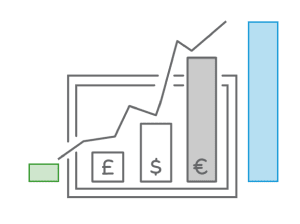This article answers the following questions:
- How are business combinations regulated in the Polish Accounting Act?
- How to set the ultimate purchase price of combination of two companies using the acquisition method?
- What are the rules of accounting for negative goodwill?
Commercial companies which carry out similar business activities independently of each other often decide to combine to achieve faster growth and a stronger market position. This is not surprising, as bringing two entities together typically offers major benefits, such as scaling up the operations of the businesses, lowering their operating expenses by eliminating overlapping structures, and more efficient application of their resources. However, in order to take full advantage of these possibilities, the combining companies must first and foremost take steps to ensure that the accounting treatment of the process is free of any errors. How are such operations regulated in the Polish Accounting Act?
Thanks to the exchange of experiences and business know-how as well as access to larger customer and supplier networks, businesses can build their competitive advantage and more easily obtain funds for new investments. As such, business combinations lead to the achievement of the synergy effect, where the cumulative potential of the entities (and their value) are higher than that of organisations which operate separately. However, before proceeding with the combination, it is necessary to make adequate preparations and gain a deep insight into the rules and regulations governing the process.
In addition to the Commercial Companies Code (Journal of Laws of 2024, item 18, as amended), the issue of business combinations is regulated in the Accounting Act of 29 September 1994 ("the Accounting Act" – consolidated text, Journal of Laws of 2023, item 120, as amended).
The issue in question is regulated in Chapter 4a of the Accounting Act. It stipulates that business combinations (by acquisition or formation of a new entity) may be accounted for using two methods defined in Article 44a:
- The acquisition method – the totalling of respective items of assets and liabilities of the acquirer (according to their book value) with appropriate items of assets and liabilities of the acquiree (according to their fair value measured as at the combination date). This method is defined in detail in Article 44b of the Accounting Act.
- The pooling of interests method – the totalling of respective items of appropriate assets and liabilities as well as revenues and expenses of the combined entities as at the combination date and following prior restatement of their values according to uniform measurement methods and making required exclusions. This method is defined in detail in Article 44c of the Accounting Act.
Learn more about our services
How to account for business combinations by acquisition?
Polish legislation treats a business combination by acquisition as a sales and purchase transaction in which the acquirer is the purchaser and the acquiree is the vendor. Thus, the acquirer agrees to pay a set price for the acquiree's assets.
For the purpose of accounting for the business combination, recorded are amounts considered as the fair values of respective assets and not values shown in the accounts.
Fair value is the amount for which an asset could be traded at arm's length, on the assumption that both parties act in a rational manner and have full knowledge of the subject of the transaction.
Measurement methods of the fair value of assets or liabilities are defined in Article 44b(4) of the Accounting Act:
- Listed securities – fair value is the current quotation less costs of sales.
- Unlisted securities – fair value is estimated value, e.g. on the basis of the price–earnings ratio and dividend yield of peer companies.
- Accounts receivable – fair value is the present (discounted) value of amounts receivable at current interest rates less write-offs of doubtful receivables and collection costs (discounting is not necessary for short-term receivables if the difference is negligible).
- Stocks of finished products and goods – fair value is the net sales price less profit margin (i.e. costs of arranging the sale or finding a buyer).
- Stocks of work in progress – fair value is the net sales price of finished products less costs of manufacturing completion and profit margin.
- Stocks of materials – fair value is the current cost.
- Fixed assets – fair value is the market value or independent valuation, if applicable; otherwise, the current cost or manufacturing costs, taking into account wear and tear, is to be used.
- Intangible assets – fair value is the value estimated on the basis of market prices of similar assets; for goodwill or negative goodwill disclosed in the balance sheet of the acquiree, it is nil value; in the absence of adequate market benchmarks, the value that will not create (or increase) negative goodwill is adopted.
- Accounts payable – fair value is the present (discounted) value of amounts payable at current interest rates (discounting is not necessary for short-term payables if the difference is negligible).
- Provisions or deferred tax assets – fair value is the value realisable by combined companies taking into account the change in the tax and book value of the net assets of the acquiree.
Due to the fact that the acquisition method involves a sales and purchase transaction, only the acquiree’s assets and liabilities are subject to measurement. All the balance sheet items of the acquirer’s books remain unchanged.
In accordance with Article 12(2) of the Accounting Act, the acquisition method involves the acquiree closing its books as at the acquisition date, i.e. as at the day the combination (acquisition) is entered into the register. At the same time, the acquirer does not close its books.
Accounting entries are not the only thing necessary to account for the combination
It must be remembered that the acquiree’s assets and liabilities include, as at the combination date, not only items which have been recognised in the acquiree’s accounting records and financial statements to date, but also such assets and sources of funding which have not been disclosed earlier and which are identified by the combination itself. In order to be recognised, such assets and liabilities must fit the definitions of assets and liabilities prescribed in the Accounting Act.
This issue is of major importance, as it is these "concealed" or previously undisclosed assets (such as business relationships, long-time clients, or understated values) that comprise a sizeable portion of the acquisition price and largely decide on the entity's value for the investor.
The acquiree’s equity (determined as net assets according to fair value as at the combination date) is, in turn, subject to exclusion. Also excluded are mutual payables and receivables of the combining entities (as well as other similar settlements).
How to account for price excess and multi-stage business combinations?
The excess of the acquisition price over the fair value of the acquiree's net assets is specified in Article 44b(5) of the Accounting Act and needs to be disclosed as goodwill in the assets of the entity to which the property of the combined entities has been transferred or of the entity established as a result of the combination.
Example 1
Acquisition price: PLN 5 million
The acquiree's data are shown in PLN millions:
| Fixed assets | 3 | Equity | 2 |
| Current assets | 6 | Liabilities and provisions | 7 |
| Total assets | 9 | Total liabilities and equity | 9 |
Goodwill: PLN 3 million [PLN 5 million – (minus) PLN 2 million].
How to account for business combinations which are spread over time?
If the procedure takes place as a result of a sequence of transactions, each of them needs to be accounted for separately.
The following items should be determined separately for each transaction:
- the acquisition price,
- the fair value of the acquiree's net assets (as a percentage reflecting the proportion of the acquired rights to net assets),
- the difference between the acquisition price and the fair value of the acquiree's assets.
Each of these items should be determined as at the date of each material transaction. Importantly, Polish legislation provides for the first material transaction being conducted not later than as at the date on which the subordination relationship between the acquirer and the acquiree arises.
The ultimate acquisition price, the fair value of the acquiree's net assets, and the difference between the acquisition price and the acquiree's net assets as at the combination date is a total of respective amounts as at the date of respective material transactions.
Adjustment of incorrectly determined fair value
If, as a result of events occurred or information obtained, fair value as at the combination date was incorrectly determined, the carrying amount of assets and liabilities determined as at the combination date is adjusted in future reporting periods.
In such a case, accountants must remember to adjust the value of goodwill or negative goodwill accordingly, provided that the entity expects to recover the amount arising from the adjustment from future economic benefits, and that the adjustment is made within the fiscal year in which the combination occurs. Otherwise, the adjustment of the value is recognised as other operating revenue or other operating expenses accordingly.
If the terms of the business combination provide for an adjustment of the acquisition price as a result of specific future events, the adjustment is recognised at the time the acquisition price as at the combination date is determined (if the occurrence of events causing the adjustment of the price is probable, and the amount of the price adjustment can be reliably determined). However, if no events giving rise to changes in the acquisition price occur in future reporting periods (or the actual price change differs from the estimated value), an adjustment of the acquisition price and goodwill or negative goodwill must be made accordingly.
Measurement period of business combinations according to IFRS 3
A different approach to the measurement period of business combinations is included in the International Financial Reporting Standard 3 (IFRS 3).
It states that if the initial accounting for a business combination is incomplete by the end of the reporting period (in which the combination occurs), the acquirer reports in its financial statements provisional amounts for the items for which the accounting is incomplete.
During the measurement (business valuation) period as regulated by IFRS 3, the acquirer retrospectively adjusts the provisional amounts recognised as at the acquisition date in such a way as to reflect new information about facts and circumstances which existed as at the acquisition date and – if known – would have affected the measurement of the amounts recognised as at that date. During that period, the acquirer also recognises additional assets or liabilities (if the acquirer obtains new information about facts and circumstances that existed as at the acquisition date and – if known – would have resulted in the recognition of those assets and liabilities as of that date).
In accordance with IFRS 3, the measurement period ends as soon as the acquirer receives the information it was seeking about facts and circumstances that existed as at the acquisition date or learns that more information is not obtainable. However, the measurement period cannot exceed one year from the acquisition date.
Business combinations and amortisation
In accordance with Article 44b(10) of the Accounting Act, goodwill is amortised throughout the entire useful life.
If the useful life cannot be reliably determined, the amortisation period of goodwill cannot exceed five years. The straight-line method is adopted for amortisation, and it is recognised as other operating expenses.
Negative goodwill – excess of the fair value of the acquiree's net assets over the acquisition price up to the fair value of acquired fixed assets, excluding long-term financial assets listed on regulated markets – is recognised as deferred income throughout a period representing the weighted average of the useful life of the acquired depreciable and amortisable assets. Negative goodwill in excess of the fair value of fixed assets, excluding long-term financial assets listed on regulated markets, is recognised as income on the combination date (in accordance with Article 44b(12) of the Accounting Act).
Example 2
Acquisition price: PLN 1 million
The acquiree's data are shown in PLN millions:
| Fixed assets | 3 | Equity | 2 |
| Current assets | 6 | Liabilities and provisions | 7 |
| Total assets | 9 | Total liabilities and equity | 9 |
Negative goodwill: PLN 1 million [PLN 1 million – (minus) PLN 2 million].
It must be remembered that negative goodwill is recognised as other operating revenue up to the amount it pertains to future losses and expenses (estimated reliably), determined by the acquirer as at the combination date, but not constituting a liability. Negative goodwill is recognised in the reporting period in which the losses and expenses affect the financial result of the entity. If the losses and expenses are not incurred in previously expected reporting periods, the corresponding goodwill is recognised in the manner specified above.
Different rules on accounting for negative goodwill are included in the said IFRS 3. Negative goodwill is not deferred, but immediately recognised in the income statement.
Accounting for combination costs
In accordance with Article 44b(6) of the Accounting Act, costs directly related to a business combination increase the acquisition price. Formation costs incurred as a result of establishing a new joint-stock company (or costs of increasing the share capital for the purpose of the combination) decrease the supplementary capital of the acquirer or of the new company established as a result of the combination up to the share premium. The remaining portion is recognised as financial expenses.
However, it is not allowed to include costs directly related to a combination in the acquisition price under IFRS 3. In accordance with this standard, all such costs should be recognised as other operating expenses.
Business combination by acquisition is a lengthy process which demands a lot of attention
It is worth noting as a final remark that the financial statements prepared at the end of the reporting period within which the combination occurs must contain comparative data for the previous fiscal year, that data being the data from the acquirer's financial statements.
Even though it is beneficial from the strategic point of view, a business combination entails numerous accounting and taxation challenges, which require professional knowledge and experience to handle. The differences between the Polish Accounting Act and IFRS 3 in accounting for goodwill or transaction costs may lead to substantial discrepancies in financial reporting, while the specificity of presenting comparative data or recognising costs of share issue necessitates a thorough analysis. In order to comply with relevant regulations and avoid errors, it is crucial to consult experienced auditors and transaction advisory experts.








